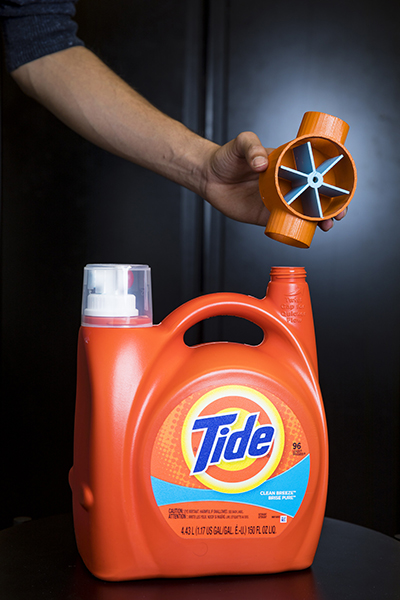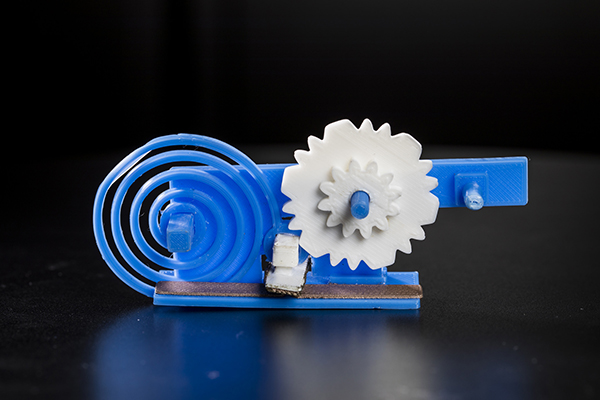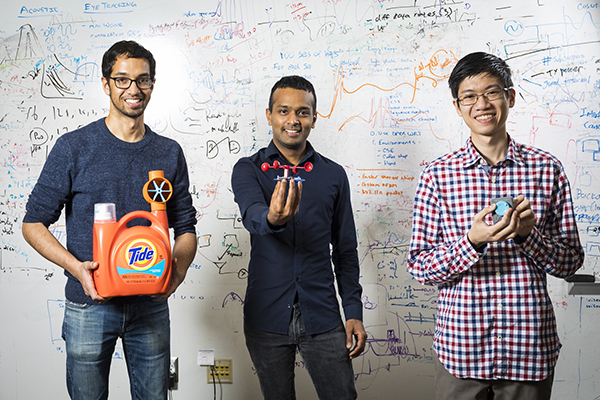Researchers in the Allen School’s Networks & Mobile Systems Lab have created the first smart objects made entirely of 3D-printed parts that are capable of communicating over WiFi. The project, which builds upon team members’ pioneering work on backscatter communication, will enable new capabilities for the Internet of Things and smart-home applications without the need for batteries and other electronics.
“Our goal was to create something that just comes out of your 3-D printer at home,” Vikram Iyer, Ph.D. student in electrical engineering and co-lead author of the research paper, explained in a UW News release. “But the big challenge is how do you communicate wirelessly with WiFi using only plastic?”
Iyer and colleagues Justin Chan, a Ph.D. student in the Allen School and co-lead author of the paper, and Allen School professor Shyam Gollakota leveraged old and new techniques to address that challenge. The team combined the physical action of gears, coil springs, and other components — reminiscent of how a mechanical watch keeps time — with backscatter, a method of wireless communication in which devices transmit data by reflecting ambient radio frequency (RF) signals that are then decoded by a WiFi receiver.
 To bridge the mechanical and the digital, the researchers 3-D printed components using commercially available filaments that combine plastic with a conductive material such as copper or graphene. As the components are triggered by a physical action, the conductive switch intermittently connects and disconnects with the object’s built-in antenna. A turning gear, encoded with 0 and 1 bits based on the absence or presence of a tooth, toggles the backscatter switch from its reflective to non-reflective state to produce signal patterns that are decoded by the WiFi receiver. The objects are powered through energy harvested as part of the physical interaction, stored in plastic springs, or produced by 3D printable sensors.
To bridge the mechanical and the digital, the researchers 3-D printed components using commercially available filaments that combine plastic with a conductive material such as copper or graphene. As the components are triggered by a physical action, the conductive switch intermittently connects and disconnects with the object’s built-in antenna. A turning gear, encoded with 0 and 1 bits based on the absence or presence of a tooth, toggles the backscatter switch from its reflective to non-reflective state to produce signal patterns that are decoded by the WiFi receiver. The objects are powered through energy harvested as part of the physical interaction, stored in plastic springs, or produced by 3D printable sensors.
To illustrate the practical applications, the team produced a 3-D printed flow meter that can be attached to a bottle of laundry detergent to measure how much liquid is used each time it is poured. By tracking usage and transmitting information about when the contents are running low, this handy add-on turns a regular plastic bottle into a smart object capable of measuring and maintaining a steady supply of an essential household item.
“The speed at which the gears are turning tells you how much soap is flowing out,” explained Gollakota. “The interaction between the 3-D printed switch and antenna wirelessly transmits that data. Then the receiver can track how much detergent you have left and when it dips below a certain amount, it can automatically send a message to your Amazon app to order more.”
 In addition to devices for measurement and tracking, the researchers developed wireless buttons, knobs, and sliders that can be used as battery-free controls for interacting with various systems throughout the home, from adjusting the volume of music to turning on the lights. They also experimented with a filament containing a combination of plastic and iron, taking advantage of its magnetic properties to embed data within the object itself as multiple sequences of bits. The encoded information can be read by a smartphone.
In addition to devices for measurement and tracking, the researchers developed wireless buttons, knobs, and sliders that can be used as battery-free controls for interacting with various systems throughout the home, from adjusting the volume of music to turning on the lights. They also experimented with a filament containing a combination of plastic and iron, taking advantage of its magnetic properties to embed data within the object itself as multiple sequences of bits. The encoded information can be read by a smartphone.
“It looks like a regular 3-D printed object but there’s invisible information inside,” noted Chan. Potential applications include inventory tracking and robot-object interaction.
The team presented its work at the Association for Computing Machinery’s recent SIGGRAPH Asia Conference and Exhibition on Computer Graphics and Interactive Techniques in Bangkok, Thailand.
To learn more, visit the project website here and read the UW News release here. To 3-D print your own smart objects, download the research team’s CAD models here.


